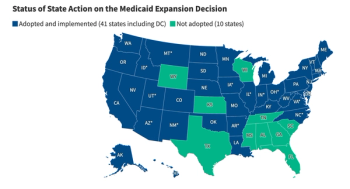
The Convergence of High Tech and Healthcare
The growth of digital twin technology — paired with the transition towards personalized medicine — has left many healthcare industry professionals evaluating the potential of a “patient twin.”
If you were to conduct a survey at random and ask people the first word that comes to mind when they think of “healthcare,” what words do you think they would share? Many might say “hospital,” “doctor,” “medicine,” “patient,” or “lifesaving.” But how many would say “technology”?
Life-saving technology is deeply engrained in the healthcare industry; in fact, technological innovation has propelled the industry forward and helped save countless lives and cure countless diseases. Despite this, many healthcare industry experts believe that the ability of the healthcare sector to fully embrace technology’s full potential
This begs the question: does the healthcare industry have a technological innovation problem? Understanding all that new healthcare technology has to offer — while a point of contention for the potential negative effects — is the key to unlocking even more lifesaving capabilities.
Embracing open innovation has been a plea for many healthcare industry experts who believe that while technology already plays a key role in this sector, there is still untapped potential that can drive true digital transformation.
Data opportunities for wearable devices
It is safe to speculate that the majority of Americans today own at least one personal device. Whether a cell phone, tablet, wearable device, or one of the many other personal devices on the market, consumers more than ever are carrying their life in their hands.
What’s further,
Access to this type of measured and objective data has the potential to solve many physician challenges, especially those related to data errors. Most of the data collected by physicians or in hospitals is self-reported, which leaves room for patient error. For example, a patient may report that they exercise the recommended three to five days a week when, in reality, they do not exercise at all. This can alter the effectiveness of their treatment because the data being provided to the doctor does not match the truth.
This distinction between self-reported data versus objective data could be the difference in an effective versus ineffective treatment. However, specifically in the US, privatized healthcare and patient privacy are of paramount importance. The
Personalized healthcare with 'patient twins'
The growth of digital twin technology — paired with the transition towards personalized medicine — has left many healthcare industry professionals evaluating the potential of a “patient twin.” This technology would
There are three major potential applications of patient twins currently being evaluated:
- Personalization and faster digitization of patient history. Patient twins can improve Electronic Medical Record (EMR) capturing, increase efficiency, and remove the need for time-consuming patient history reports – all while personalizing treatment and patient care.
- Population mining. Patient twins can allow healthcare practitioners to effectively provide customized population information. For example, consider a patient that has high blood pressure. By evaluating that patient’s relevant demographic information (age, race, geography) and pairing it with their medical history, doctors can then compare that patient twin against the renderings of other patients with that same medical and demographic background to evaluate which treatment may work best.
- Clinical trials. Patient twins can be useful for clinical trials and the development of more targeted therapies, as participants can be sourced digitally from across the globe.
Healthcare as aservice
Many healthcare experts also believe that the structure and economic model of healthcare should be reevaluated. If you think about how healthcare operates, it is a two-pronged approach: healthcare and insurance. As a general rule of practice, the majority of individuals purchase insurance even if they are perfectly healthy.
While insurance is not going anywhere, the modern generation of consumers is demanding not only personalization, but increased autonomy over their personal information. This makes way for a healthcare-as-a-service model, where consumers can purchase additive services for increased access to their health data.
Consumers want personalized convenience, even when it comes to healthcare. Allowing a pay-per-month model where customers can access their chart, patient twin, health data, and beyond could be yet another technological opportunity for next-generation healthcare.
Benefits of digital healthcare
The growth of digital healthcare, while certainly faced with several challenges, also has the potential to usher in real benefits.
From a physician’s perspective, many doctors are not satisfied with the current operating model, as the “care” element of healthcare seems to be lacking. Many doctors spend their days working through paperwork and other logistical tasks rather than treating patients. The
The value generated through digital health extends far beyond the physician. Advancements in telemedicine have significantly benefitted patient lives and drug development in a variety of exciting ways. For example, doctors have uncovered new ways of giving neurological and other exams virtually, meaning that patients with advanced-stage diseases — who may have trouble commuting to an office — can still receive adequate treatment. Patients can now participate digitally in clinical trials, which can accelerate drug development and disease prevention. These benefits are truly lifesaving and have the potential to benefit many patients’ lives.
The increased digitization of the healthcare sector is being closely watched by experts, practitioners, enterprises, and civilians alike. As this journey continues, it is essential from a technology evolution perspective that leaders ensure that digital health is treated as an integral part of the value chain, not as an afterthought.
Sheetal Chawla is head of life sciences, head of northeast region, Capgemini Americas. Jiani Zhang is executive vice president and chief software officer, Capgemini Engineering.
Newsletter
Get the latest industry news, event updates, and more from Managed healthcare Executive.






















































